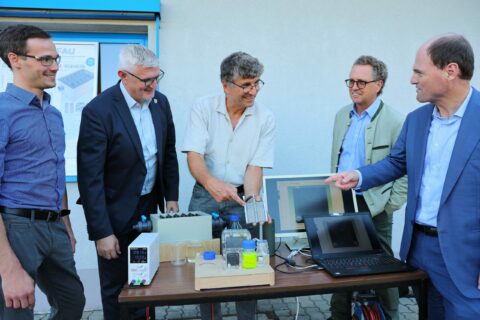Prof. Dr. Rosiwal and his research team develop prototype for clean water

It may have been unconscious, but the attentive observer noticed it nonetheless: when Professor Dr. Ing. habil. Stefan M. Rosiwal announced the words “world first” and spoke of “international pioneering role” at the wastewater treatment plant in Hausen, the chests of the two mayors Bernd Ruppert (municipality of Hausen) and Benedikt Graf von Bentzel (municipality of Heroldsbach) swelled a little. In the sewage treatment plant operated jointly by the two municipalities, for which Ruppert as chairman and his colleague von Bentzel as deputy are responsible, very special diamond electrodes as the 4th treatment stage will in future ensure a significant improvement in the quality of the treated wastewater that is ultimately discharged into the Regnitz.
During the presentation in front of the sewage treatment plant keeper’s house on the outskirts of the village, Rosiwal added one more thing, much to the delight of the two chairmen: “It doesn’t cost the wastewater association any money!”. His gaze wandered to a hitherto rather quiet guest, the local constituency representative Michael Hofmann, who made this project a reality with all his political willpower. He made 200,000 euros available through the CSU’s so-called “parliamentary group initiative” and thus ensured its implementation.
He also brought the first prototype with him to Hausen and presented the project to the public. Even if the model may have seemed rather tiny to most visitors, the ground-breaking technology of this major research project is based on decades of work at Friedrich-Alexander-Universität Erlangen-Nürnberg (FAU), explained Professor Rosiwal. The unique feature is not the diamond electrodes that remove pollutants from the water. “It is the composition of the world’s first prototype system in Hausen. Instead of the rare and very expensive metal niobium, we use ceramics from Selb. The synthetic diamond structure is produced in Erlangen in special furnaces that are the only ones of their size in the world. It is therefore a regional, a purely Franconian product, so to speak.” The research team hopes that the use of the far more cost-effective ceramic will allow wastewater to be treated and purified much more economically in the future. To prove this, the system is to be installed at the sewage treatment plant in Hausen.
The extensive basic research for this has been carried out for many years with generous funding from the Bavarian Research Foundation. Now it’s time for implementation. “Putting it into practice now is an important step,” said Rosiwal at the presentation. “We want to prove that we can still significantly reduce the concentration of residues in wastewater by over 99%. This will be particularly interesting for substances such as oestrogen, antibiotic residues and PFAS, because these substances can actually have serious consequences for flora and fauna,” the professor explained to the attentive guests from the municipalities of Hausen and Heroldsbach. Using the small model, his team demonstrated how the diamond electrodes work as a 4th purification stage to illustrate this for the layman. “It’s a very promising solution. If we can improve the quality of the discharge water into our waterways in this way, it’s a great achievement,” said Mr. Hofmann, expressing his enthusiasm for the concept. Projects as a 4th purification stage are already being tested elsewhere. He was convinced by the fact that, unlike others, the process does not require ozonation, which is an outstanding advantage.
“This performance had prompted me to attract funding to the district. The regional added value was a second important factor. And because the process ultimately produces 20% hydrogen as a ‘waste product’ for usable energy, we are close to the egg-laying wool-milk sow for sewage treatment plants,” laughs Hofmann. He is particularly pleased that the research project is being realized in his constituency in Hausen: “The basic requirements for operation were exactly right here and the two association chairmen Bernd Ruppert and Benedikt Graf von Bentzel immediately signaled their willingness to cooperate.” The funding from the Free State will initially secure research in Hausen until the end of 2024, and Hofmann is fairly certain that it will continue after that.